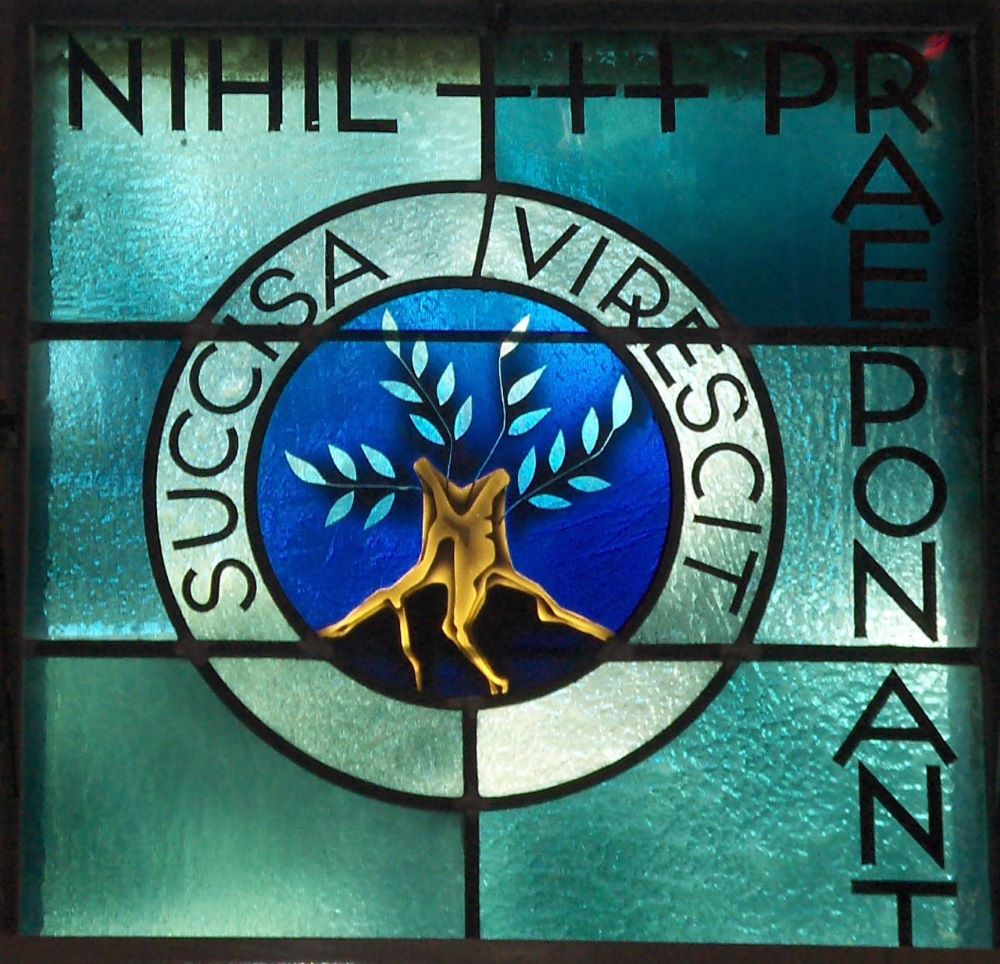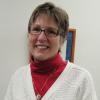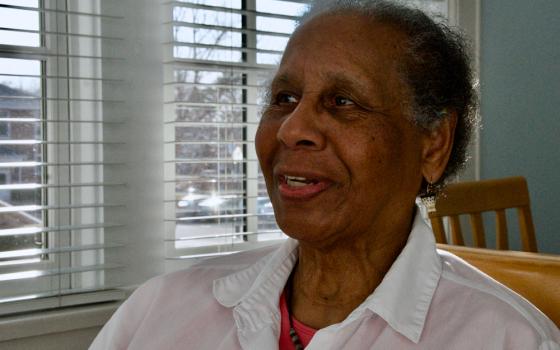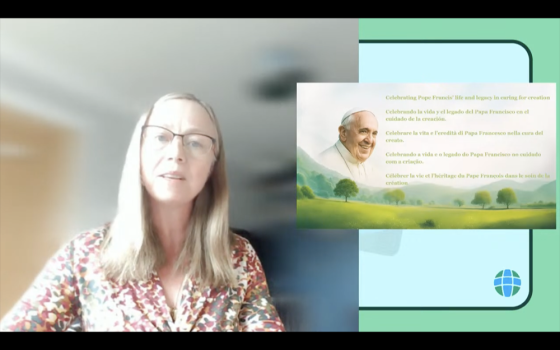
The in-person portion of the Federation of St. Scholastica colloquium was held June 15-19 at Mount St. Scholastica Monastery in Atchison, Kansas. Pictured is a stained-glass window in the monastery's choir chapel. (Courtesy of Mount St. Scholastica Monastery, Atchison, Kansas)
Editor's Note: This is the first of two reflections about the 100th anniversary of the Federation of St. Scholastica.
None of us know which of our moves will be the one that shifts the sand in just the right way so that we are able to free ourselves of mindsets and institutions and unquestioned assumptions that keep us buried in the past. We do not know which idea or effort will be the one that really matters.
The Federation of St. Scholastica, comprised of 17 Benedictine women's monasteries, celebrated the shift that led our foremothers to form the federation, to claim our authority as women in the church, 100 years ago in 1922. We celebrated in the usual way with historical displays, celebratory meals and programs, a specially composed song, and an anniversary publication, at our quadrennial Federation Chapter held at Mount St. Scholastica in Atchison, Kansas, June 15-19.
Then we shifted the sands again by inviting oblates and seekers to join professed members for a two-day colloquium, "Benedictine Life: A Vision Unfolding."
It was a bold step to acknowledge that the Benedictine tradition is not solely the domain of those who have professed their entire lives to living it. It was visible proof that we are in a different place than we were 100 years ago, or even 50 years ago, and that there are varied ways to live Benedictine spirituality, and that interest in monasticism is growing even as the number of those who choose to make a lifelong commitment to living it in a monastery is decreasing.

"St. Benedict Gesturing to the Left; Study for the Coronation of the Virgin" (1520-23) by
Correggio (Artvee)
The colloquium planners intentionally created a hybrid event, equally onsite and virtual, to include a broad range of participants and presenters and to recognize that technology has made geographical challenges amorphous even if we are still bound by time zones. Registrants included 250 followers of Benedict — women, men, professed, oblate, and seekers, 100 with the intent of being present in Atchison at Mount Saint Scholastica and another 150 who would join virtually.
In an unfortunate reminder of our human vulnerability, two sister delegates tested positive for COVID and the colloquium adjusted to completely virtual. Some of the symbolism of the gathering was lost, but an even greater loss was our ability to be with one another, informally discuss ideas, sit in one another’s real presence, and pray.
It is not up to us to see the future, whether we're looking at it virtually or gathered in a physical place. Tomorrow will become today with or without us, and we really have no guarantee what it will be when it arrives, or even if it will arrive for any one of us. Our task is to inform ourselves, to think, pray and reflect, to question all that has been handed to us because we do not live in a static world. Our gift of spirit and intellect and our option to change as new information becomes available is key to our human development and the wellbeing of our world.
In the measure that we open ourselves to different thoughts and choices today, when today becomes yesterday, a different past will be informing and shaping our next tomorrow. In openness to change, in foregoing restrictive thinking, we leave the best gift possible to future generations.
This gathering, then, was about seeing and thinking differently, both past and present, so that the Benedictine charism is carried into the future in a healthy and life-giving way. The planning committee, monastic women from six monasteries, spent months formulating goals for the four-year celebration that began in 2018. The goals were:
- Make our Benedictine way of life visible and accessible in new ways to today's seekers by celebrating our history and envisioning our future.
- Share our lives as Benedictine women, past and present, what we stand for, and why we do what we do as we invite others to experience our charism and good zeal and to join us in "running while we have the light of life" (Prologue, Rule of Benedict).
- Support Benedictine life today so that it can continue to be the same kind of stabilizing presence in our cities and towns and light for spiritual seekers that it has been for more than 1,500 years.
They wrote and published a prayer and set up a website where 15 sisters from different monasteries took turns sharing weekly reflections during the four years leading up to the Chapter and Colloquium. They posted podcast interviews with sisters young and old, with oblates, benefactors and alums. The idea was to invite seekers into Benedictine life and spirituality, an invitation that would culminate in the gathering that took place in June. The key difference was the wide net they cast. This was to be a gathering of all those seeking God through the Benedictine charism.
Like the intended audience, the eight women asked to present papers and to respond to them represented different ways of living Benedictine life. The format was simple: one speaker each day on each of the three goals followed by a response to the insights of the day. The wisdom of participants was also gathered in small group sessions. Due to the COVID cancellation of onsite participation, the breakout rooms each day were via Zoom. In addition, two open conversations were held each day in an effort to have the greatest interaction possible.
The papers and responses will be published and recordings of the presentations will eventually be available through Benedictine networks.
Advertisement
The colloquium charged participants with seeing and thinking differently. Papers expertly examined the interpretation of history, presented models of change, addressed theories of emergence, testified to the value of Benedictine life in the world, and held up Benedictine monasticism, already being lived in new ways, as a path as useful for following the gospel today as it was 1,500 years ago. The choice is ours.
It is not about imposing tasks or rules or even behaviors, or about building institutions or staking out turf. It's about making sure there are new sprouts ready to take hold even as current forms die.
And we know all living things eventually die. The most beautiful tree will topple when its roots have died and it is no longer anchored. Then it becomes a source of food and energy for new growth. When our tree topples — as it will — new shoots already yearn to grow and flourish around it, to be nurtured by it. We can let go of fears about the future and look beyond short-sided desires to remain the same and know that Benedictine life will become what it is meant to become.
We can say together, "Succisa virescit." These words, which mean "cut down, it grows up strong again,” appear on the crest of the Abbey of Monte Cassino, founded by St. Benedict in Norcia, Italy, in 529. It’s an apt motto as Monte Cassino has been destroyed and rebuilt many times.
We have no doubt that Benedictine monasticism will continue to seed our world with the values it so dearly needs. What we don't know is which ideas or efforts will eventually take shape. And that really doesn't matter. Succisa virescit.







